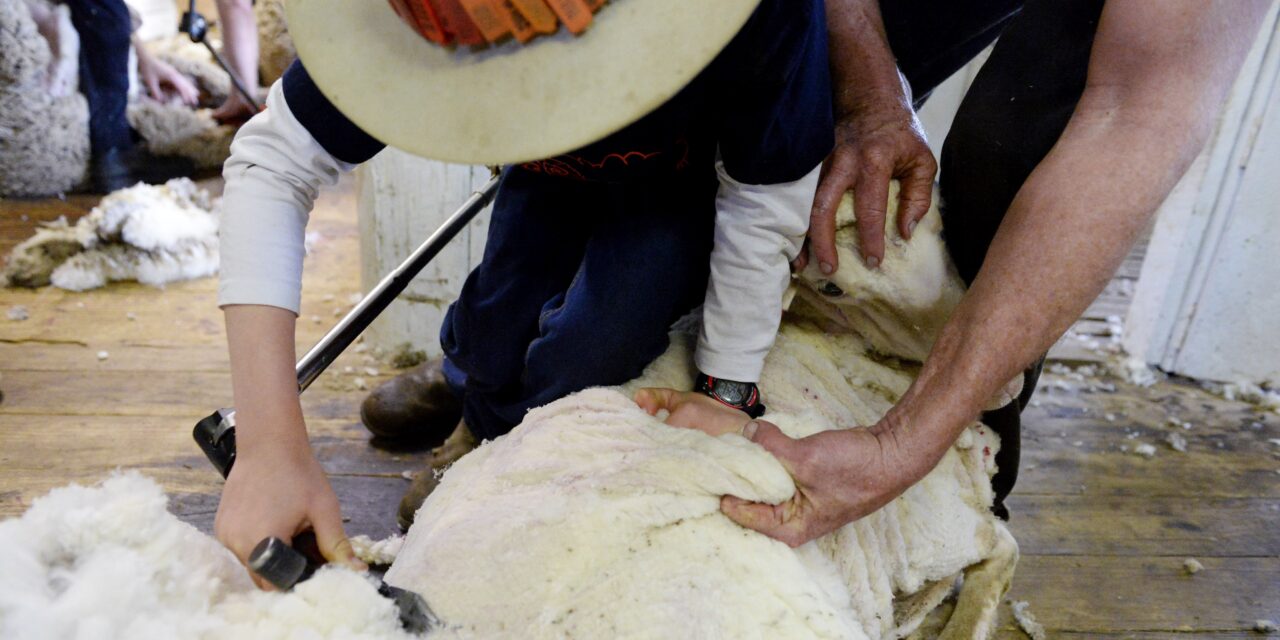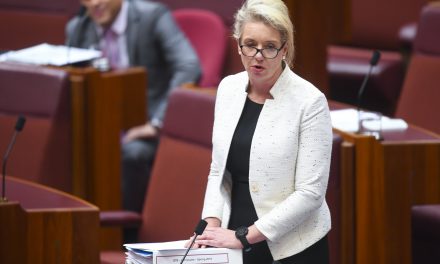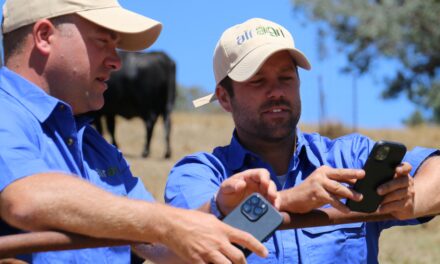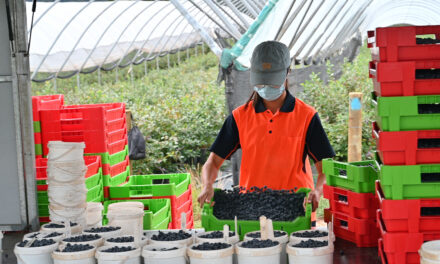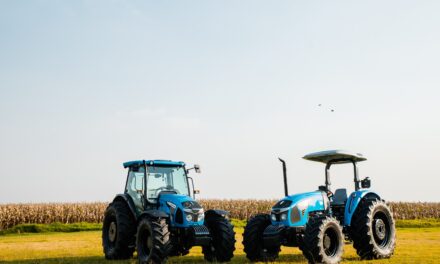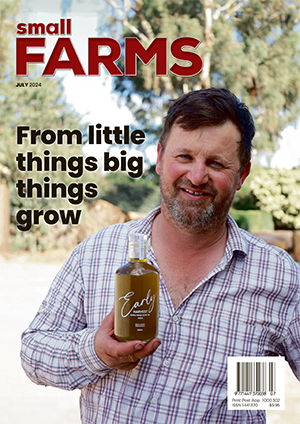A sheep farmer and a teacher have put their heads together and come up with a clever gadget to keep track of what’s happening in the shearing shed and beyond.
When you spend long enough at the crutching trailer, you also have long enough for some pretty strange ideas to start bouncing around your head.
Such as how many sheep have you done because right now it feels as if you have been slacking off all day.
Scott Leslie probably wasn’t really slacking, but his count for the day might have been down a little.
Which is when he started imagining some sort of fancy digital tally counter to keep track of it all — not just the number on the day, but every sheep you ever crutch.
Or shear.
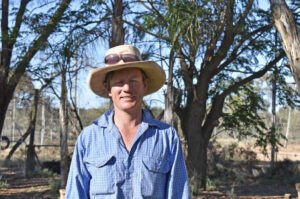 There are, Scott knows, a lot of shearers floating around Australia; New Zealand’s full of them and there’s bound to be plenty in South America and even North America (and then there’s the Poms).
There are, Scott knows, a lot of shearers floating around Australia; New Zealand’s full of them and there’s bound to be plenty in South America and even North America (and then there’s the Poms).
So lots of shearers, lots of sheep and as far as Scott was aware, no-one had thought to hook it all up with some snazzy little digital doohickey — one that kept count, tracked where you were, what the weather was like, and could regurgitate it all at the push of a button. You could have it in a graph, pie chart, table, anyway you wanted.
It is, Scott says, all about data, data, data.
There was his lightbulb moment, 10 years ago, and he just couldn’t get it out of his mind.
Especially the bit about digital technology. Scott admits what he knew about that would also fit in the little digital counter he was visualising, with room to spare.
“What really got my attention was being able to know how long each sheep was taking, and there is a lot more crutching than shearing in the sheep industry,” Scott explained.
“I knew I needed to talk to a digital guru so caught up with Sam Thompson over a few drinks at a barbecue.
“He’s a teacher — maths, science and, yes, tech — and I started to tell him what I was thinking about.
“So with my practical input and his technical wizardry we are working towards a prototype, which we hope to be trialling some time next month with a shearer we have lined up and once we see it in action we will be able to start fine-tuning.”
But like everyone else in the world, COVID-19 has played havoc with access to all sorts of imported gear the duo would like to get their hands on — especially printed circuit boards. But they hope to have that solved shortly.
The prototype is about the same size as the traditional counter used in a shearing shed, about 7cm x 5cm. But theirs incorporates Bluetooth and, as every shearer has a mobile phone, Scott says they have already made the biggest financial investment connected with the project.
He says as they are planning to market their tally counter — working title ‘Sheepo’ — around the world, they must be able to update it via the internet or it just won’t meet the market.
Even in sheds out in the middle of nowhere, without internet access, Sheepo will still get the job done. And then when you move on and come back into range it will be synchronised on your phone and you just upload it to the cloud.
“We thought we would test the water and went on Facebook telling people what we were developing and we got fantastic interest from all over the world, so we think it has a ready market once we get it perfected,” Scott said.
Of course there is one other little problem.
Scott’s also a working farmer and right now, on the verge of launching Sheepo Mark 1, he is as flat out as the proverbial lizard drinking just keeping up with all that routine stuff.
As routine as 5000 pure Merino sheep, 2500 hectares of wheat, barley and vetch, and — once he has the crops in and the flock on its best behaviour at the family’s Euston property in western NSW — he’s headed south to his family’s other farm, to help them catch up with their cropping, their sheep and their prime lamb enterprise with White Suffolks being put over the older Merino ewes.
“Yep, we certainly are a little time poor right now, which is a good thing, really, because it means we have had good rain and it means the outlook is also good,” he said.
“We’ve had 160mm for the year to date — in 2020 we didn’t get anywhere near that much for the year.
“The year before was even worse, in 2019 instead of our 5000 head capacity, we were down to 500 sheep here and what we could get was out on agistment.”
Scott’s 20-micron flock is based on Tamaleuca blood from Ouyen and he’s pretty happy to see so many of them in his paddocks — and to see the rain still falling.
Switching from sheep back to Sheepo, Scott said once he and Sam decided they had a potential goer, he approached the Farmers 2 Founders (F2F) Ideas program (now named the Hatch program).
A three-month course, it is designed to equip primary producers with the skills to not only test their ideas but also build their capability and confidence to launch new products and services.
Scott said it was essential, giving him the business 101 he really needed because he did not go around setting up an agtech business every year or so.
Out of more than 50 applicants from across Australia, Scott was selected as one of 11 to join the annual program, providing him with access to the likes of workshops, a business coach and an IP (intellectual property) lawyer.
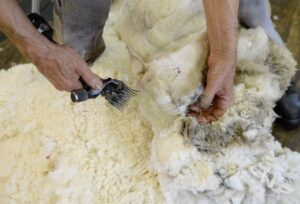 As part of the training, he was joined by Sam to conduct a series of interview panels with shearers, explaining Sheepo — their ‘robust’ Bluetooth tally counter — would log their sheep count and time data to their mobile phones, helping them track and potentially improve their shearing performance.
As part of the training, he was joined by Sam to conduct a series of interview panels with shearers, explaining Sheepo — their ‘robust’ Bluetooth tally counter — would log their sheep count and time data to their mobile phones, helping them track and potentially improve their shearing performance.
Scott said it could also help shearers estimate their future income and could potentially automate the invoicing process.
“So during the F2F program, Sam and I did a round of interviews with shearers of various ages, as well as contractors and farmers, to primarily determine whether there would be a demand for a digital tally counter.
“Not surprisingly we learnt younger shearers are more interested in new technologies, and see more value in the data they could gain from a counter (for example, benchmarking, wages, etc).
“We also learnt shearing contractors are interested in knowing which shearers work consistently as well as having a record of which shearers are shearing more sheep on average.”
Based on these insights, Scott and Sam gained the confidence to build their initial model and they are still hopeful they might have it ready for commercial release towards the end of next year.
“I found the F2F program to be fantastic. I see it as my 101 into co-founding an agtech company,” Scott said.
“It taught me that you have to do your research if you want to stand a good chance of succeeding, and that good ideas are worth giving a go.”
Helping hand to step-up to the next level
Farmers 2 Founders (F2F) is a coalition of experienced entrepreneurs, investors and thought leaders in the global agrifood tech ecosystem.
Its program operations manager, Claire Pinks, says the group came together because they are passionate about working with the whole agrifood and fibre value chain.
Claire says its core mission is to help innovative producers collaborate with agrifood innovators to develop new ideas, technologies and capabilities that will solve real industry challenges and opportunities to help build agrifood tech and innovation solutions that deliver commercial benefit and industry impact across agrifood, fibre, fisheries and aquaculture.
“We help producers to collaborate with agrifood tech developers and innovators to fast-track the development, commercialisation and uptake of these solutions to deliver positive individual farm business and industry outcomes,” Claire explains.
“Basically, we are supporting producers to be at the centre of industry innovation, starting and scaling businesses across agrifood tech and value-adding that capture value back on the farm.
“We also hope we are accelerating the journey to commercialisation for agrifood tech and innovations that deliver measurable industry impact.
“By creating a large and visible community of innovative, progressive producers who are confident and capable to develop and/or adopt new technologies and innovative solutions and actively collaborate with the broader agrifood tech and innovation ecosystem we are helping create the farming industries of the future.”
Claire says F2F facilitates and supports engagement with, and collaboration by, agrifood innovators across the whole value chain including:
- primary producers;
- agtech developers and solution providers;
- universities and students;
- agrifood entrepreneurs and businesses;
- research teams;
- research and development corporations;
- grower groups;
- local, state and federal government;
- regional development associations; and
- corporates/agribusinesses.
“If you are looking to explore a new business idea to solve an on-farm or industry problem you need to visit the Muster, which is a place to inspire you, encourage collaboration and connect you with some of our big agrifood challenges,” Claire says.
“It is the first step in the F2F venture creation pathway and will take you on a journey to start validating your idea; find co-founders, team members or partners if you need to; turn it into a real business; and eventually scale.
“Once you submit your idea we will be in touch to help you work out which F2F program is the right one for you.”
Further details from: farmers2founders.com/the-muster

